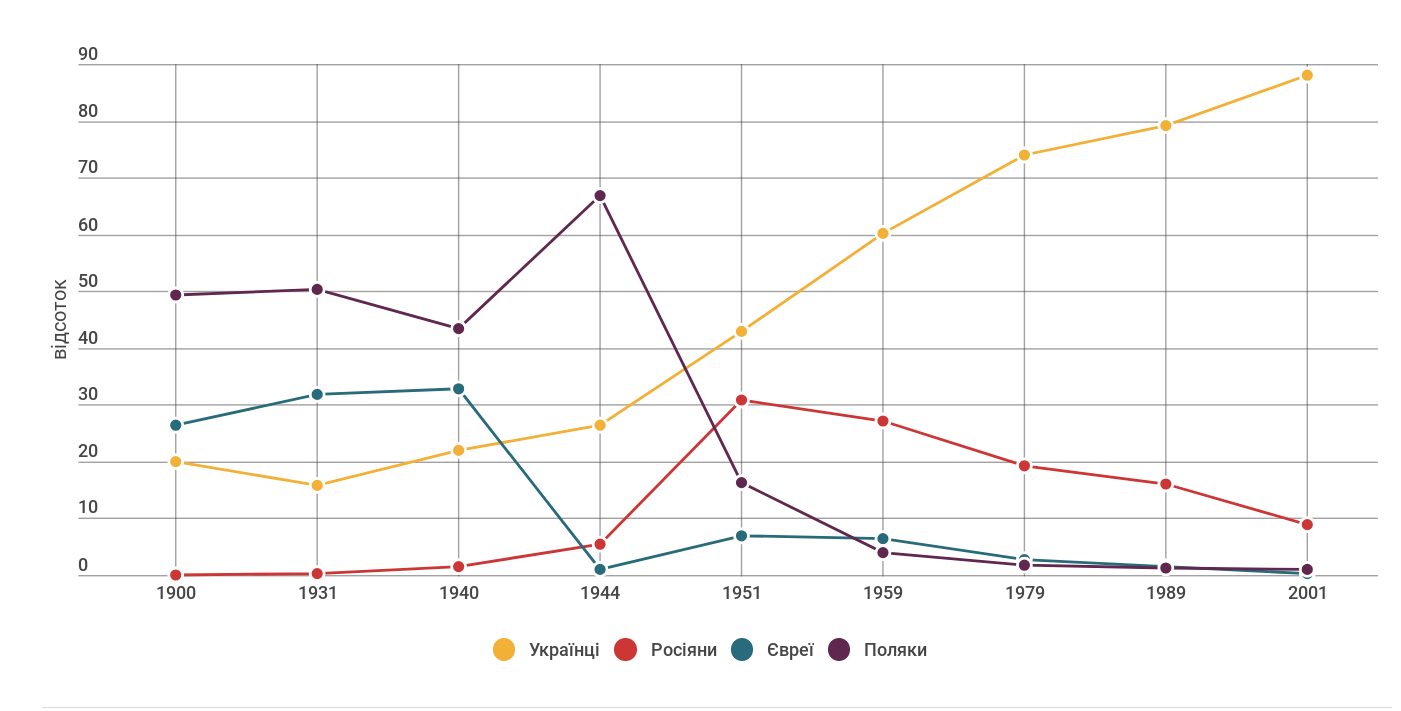
The Epilogue of the War ID: 257
Story
The theme was prepared as a part of the program The Complicated Pages of Common History: Telling About World War II in Lviv.
They went
through the war, through two or, actually, three occupations — Soviet, German
and then Soviet again. There were various people among them: those who rescued
others and those who denounced Jews. Among them, there were traitors, heroes
and ordinary dumb performers, masters of trade, masters of cunning, masters of
prayer, goodness or cruelty. Now they were meeting each other on the same
street, and they certainly knew a lot about each other, but they generally did
not pass that knowledge on to others. They survived by chance or miracle,
through providence or at a terrible price. Each of them had their own secret, astonishing
or touching. A few diaries have covered the fate of some of them, but in general
all this secret reality of memory has disappeared without a trace: the reality
of interrogations, searches, camps, escapes and incredible cases...
(Adam
Zagajewski, Dwa miasta)
Millions of Europeans were deprived of their homes as a result of flight, evacuation, deportation, resettlement or emigration during World War II. Millions of Soviet citizens were relocated through government programs or forced deportations to sparsely populated regions of the country. After World War II, the victorious nations legitimized the forced displacement of the population, in particular national minorities, as a necessary precondition for a long-term peace in Central and Eastern Europe. The Polish-Ukrainian border was a place of destructive and bloody interethnic conflicts. The resettlement, which was first called "evacuation" and then "repatriation", was to ensure stable coexistence within the new borders. While Poland lost its former eastern regions, which became part of the Ukrainian, Belarusian and Lithuanian SSRs, it gained the former German regions of Silesia and Pomerania. Poles were forced to leave Galicia and Volhynia, which no longer belonged to Poland, and settled in the ex-German "Recovered Territories" (Ziemie Odzyskane), while Ukrainians were forced to leave the San river basin, Podlasie, and Lemkivshchyna, where they had lived for centuries.
The epilogue of World War II was a new wave of forced and voluntary migration, and Lviv was at the epicenter of these processes. As a result of military losses, the Holocaust, repression, deportations and Soviet national policy, the population of Lviv in the 1940s-1950s changed dramatically, according to some estimates, by 80%; this is illustrated by the following graph representing ethno-demographic transformations in the twentieth century.

The first postwar years and the accession of Lviv and Galicia to the USSR are often considered through polar approaches to "occupation" or "liberation." In this section, we will go beyond this discussion, focusing primarily on the experiences of different communities at the end of and immediately after the war: the communities for whom Lviv was a transit point, a new home, or a hometown they had to leave forever.
- Battle for Lviv. Hill of Fame, vul. Pasichna
- Operation Storm. Ul. Kochanowskiego 23 (now vul. K. Levytskoho)
- The lost home: post-war forced relocations: Polish Evacuation Committee building, former Krakowski Hotel (now the Court of Appeal, pl. Soborna 7)
- To take Lviv with them: the resettlement and cultural heritage. Vul. Virmenska 23
- After the Catastrophe: the post-war life of the Jewish community in Lviv. Vul. Vuhilna 3
- Peculiarities of Soviet justice (Territory of Terror Museum, prosp. Chornovola 45)
- New Lviv residents and their city. "Rohatka" — the intersection of vul. B. Khmelnytskoho and vul. Volynska
Sources
- Галина Боднар "Розкіш і злидні повоєнного Львова, або реалії житлово-побутового повсякдення в омріяному місті", Україна Модерна (режим доступу від 13.02.2019);
- Софія Дяк, "Творення образу Львова як регіонального центру Західної України: радянський проект та його урбаністичне втілення", Схід-Захід:Історико-культурологічний збірник. Випуск 9-10, Харків, 2008;
- Роман Лозинський, Етнічний склад населення Львова (у контексті суспільного розвитку Галичини). – Львів, 2005;
- Степан Макарчук, "Переселення поляків із західних областей України в Польщу у 1944-1946 рр.", Український історичний журнал, 2003 - сс. 104-115;
- Тімоті Снайдер, Перетворення націй. Польща, Україна, Литва, Білорусь 1569–1999. Київ, 2012;
- Tarik Cyril Amar, The Paradox of Ukrainian Lviv: A Borderland City between Stalinists, Nazis, and Nationalists, Cornell University Press, 2015;
- Istvan Deák, Europe on Trial. The Story of Collaboration, Resistance and Retribution during World War II, Boulder, 2015;
- Catherine Gousseff. Échanger les peuples: Le déplacement des minorités aux confins polono-soviétiques, 1944-1947. Fayard, 2015;
- Grzegorz Hryciuk, Przemiany narodowościowe i ludnościowe w Galicji Wschodniej i na Wołyniu w latach 1931–1948. Toruń, 2005;
- Damian Karol Markowski, Anatomia strachu. Sowietyzacja obwodu lwowskiego 1944–1953. Studium zmian polityczno-gospodarczych, Warszawa, 2018;
- Maciej Matwijów, Walka o lwowskie dobra kultury w latach 1945‒1948, Wrocław: Towarzystwo Przyjaciół Ossolineum, 1996;
- Serhii Plokhy, Yalta: The Price of Peace, NY, 2010;
- Jessica Reinisch, Elisabeth White. (eds.) The Disentanglement of Populations Migration, Expulsion and Displacement in postwar Europe, 1944-49., Palgrave Macmillan, 2011;
- Theodore Weeks, "Population Politics in Vilnius 1944-1947: A Case Study of Socialist-Sponsored Ethnic Cleansing", Post-Soviet Affairs, 23(1), 2007, pp. 76-95.